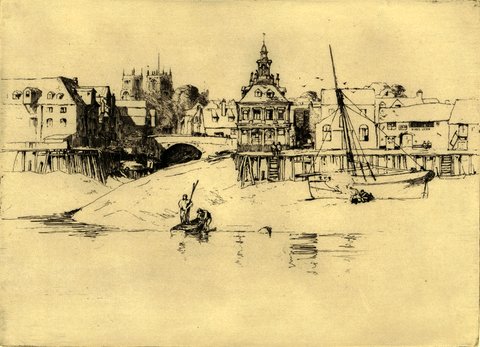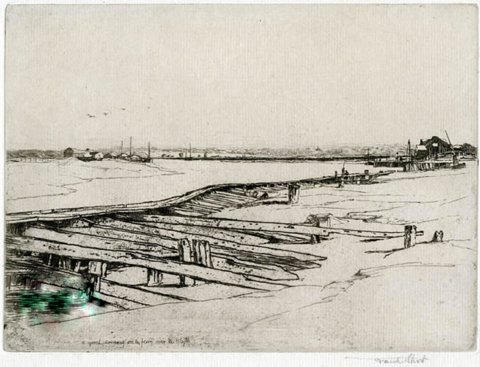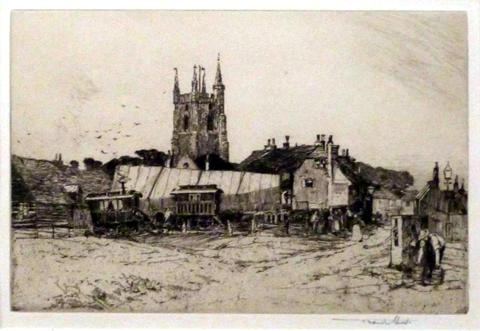SHORT, Sir Frank
As Francis Job Short, he was born at High Park, Wollaston, Stourbridge, Worcestershire on 19 June 1857, second child and only son of Job Till Short (c1832-21 February 1921), a bricklayer/builder, and his wife Emma Millward (1832-1922), daughter of William Millward of Stourbridge, who married at the Union Chapel, Stourbridge on 2 May 1854. In 1861, Frank as he was known, was a 3-year-old, living at High Park, Wollaston, with his parents, 29-year-old Job and 29-year-old Emma with three sibling sisters, Frances Job 6, Annie 2 and newly born Edith, all born at Stourbridge. Frank studied at the Stourbridge School of Art but in 1881, was a 23-year-old civil engineer, living at Bridle Road, Wollaston, Stourbridge with his parents and siblings, being engaged on various engineering works in the Midlands. Later in 1881 he came to London as assistant to Baldwin Latham (1836-1917), in connection with the Parliamentary Inquiry into the pollution of the river Thames. In 1883 elected an Associate of the Institution of Civil Engineers and in the same year joined the South Kensington School of Art, also working in the life class under Professor Frederick Brown (1851-1941), at the Westminster School of Art, and for a brief time at the Schools of the Royal Institute of Painters in Water-colours. He married at the Presbyterian Chapel, Stourbridge on 17 April 1889, Esther Rosamond Barker (1866-28 December 1925), daughter of Benjamin Barker of Australia, late of London, and they had an only child Dorothea Mary (1890-1972). In 1891 Frank was living at Aynhoe Road, Hammersmith with his 24-year-old wife Esther and their 1-year-old daughter. His real lifework now became that of an original and translator engraver and received encouragement from John Ruskin (1819-1909) and the co-operation of J. M. W. Turner's students such as William George Rawlinson (1840-1928) and the Revd Stopford Augustus Brooke (1832-1916). After completing the series from the existing plates of Turner's 'Liber Studiorum', Short turned to the subjects which Turner had left incomplete and his work bears the lettering 'F. Short, Sculp., after J. M. W. Turner, R.A.'. His own excellent quality as a watercolour painter made him a sympathetic engraver of the landscapes of David Cox and Peter De wint. Short was elected an Associate of the Royal Academy on 8 January 1906 and a Member on 25 January 1911, the same year that he was knighted, and served as the Royal Academy's Treasurer 1919-1932. Short was President of the Royal Society of Painter-Etchers and Head of the Engraving School of the Royal College of Art, where he taught 1891-1924. He exhibited at the Ipswich Fine Art Club in 1923, a dry point 'Pevent's Castle' and an etching 'The Rising Sun' and in 1932, from 56 Brook Green, London W.6 two works, a mezzotint 'A Mountain Torrent' after J. W. Müller and an aquatint 'The Evening Star in her last Berth' and two mezzotints in 1933 'Cloud Burst over the Sands of the Dee' and 'A Grey Day on the Dee Sands'. Francis Job Short was of 56 Brook Green, London when he died at The Jointure Cottage, Ditchling, Lewes, Sussex on 22 April 1945.
Royal Academy Exhibits
from 3 Radnor Street, Chelsea
1885 1594 New Inn, Poole - etching
1653 Putney Bridge - etching
from 8 Wentworth Studios, Manresa Road, Chelsea
1886 1470 Sunset on the Beach-after Copley Fielding - mezzotint
1887 1503 A North Country Fishing Village - etching
1505 Grey Morning: Whitby - etching
1545 In Cider Country-after Alfred Parson - drawing
1888 1712 Mezzotint-after Alfred East
1889 1685 The Curfew - aquatint
1700 Hayle - etching
1705 Rye Port - etching
1720 Orpheus and Eurydice-after F. Krause - etching
1792 A Road in Yorkshire-after De Wint - etching
1890 1616 Twilight on the Campagna-after G. Costa - etching
1632 Low Tide and the Evening Star - etching
1683 Day's Dying Glow-after J. Farquharson - etching
1684 Flatford Lock-after J. Constable, R.A. - etching
1891 1226 The Breaking up of the 'Great Eastern' - watercolour
1562 The entrance to the Mersey - etching
1568 Near Hingham, Norfolk-after J. Crome - etching
1590 The Breaking up of the 'Great Eastern' - etching
1686 Swiss Pass-after J.M.W. Turner, R.A. - etching
1690 The Mouth of the Thames-after J.M.W. Turner, R.A. - etching
1695 A Sussex Down-after J. Constable, R.A. - etching
1892 1477 Diana and Endymion-after G.F. Watts, R.A. - etching
1893 1350 The Solway - etching
1398 Gathering the Flock on Maxwell bank - etching
from 56 Brook Green, West London
1894 1486 'When the weary moon was in the wane' - etching
1510 Evening on the Solway - etching
1896 1580 Mouth of the Medway-after J.M.W. Turner, R.A. - etching
1897 1584 Falls of the Rhine, Schaffhausen-after J.M.W. Turner, R.A. - etching
1603 Lucerne-after J.M.W. Turner, R.A. - etching
1604 Pastoral-after J.M.W. Turner, R.A. - etching
1899 1570 Sir George Johnson, M.D., F.R.S.-after Frank Holl, R.A. - etching
1904 1311 Lord Tennyson-after G.F. Watts, R.A. - etching
1323 A Vessel in Distress-after J.M.W. Turner, R.A. - etching
1418 A Yorkshire Hayfield-after P. de Wint - etching
1905 1315 Portrait of Two Gentlemen-after Sir Joshua Reynolds, R.A. - etching
1354 The Waning of the Moon - etching
1906 1309 A Yorkshire Dell-after J.M.W. Turner, R.A. - etching
1907 1430 Boats carrying...to the Dutch men-of-war in 1665-after J.M.W. Turner, R.A. - etching
1908
1909
1910
1912
1913
1914
1916
1918
1919
1922
1925
1927
1928
1929
1930
1931
1932
1933
1934
1935
1936
1937
1938
1939
Works by This Artist

|
King's LynnEtching
|

|
A Quiet Evening on the Ferry over the BlythOriginal etching
|

|
Strolling Players at LyddEtching
|